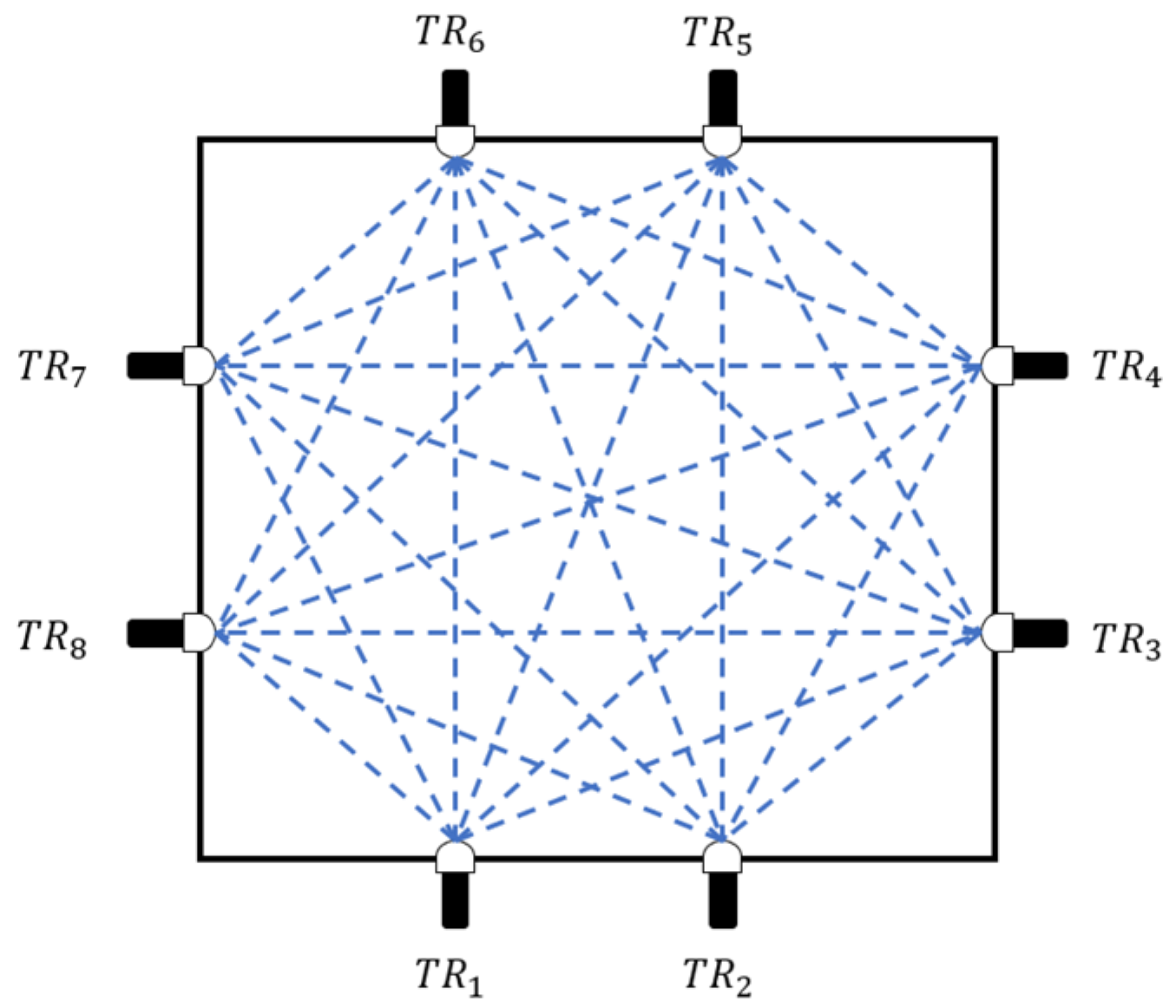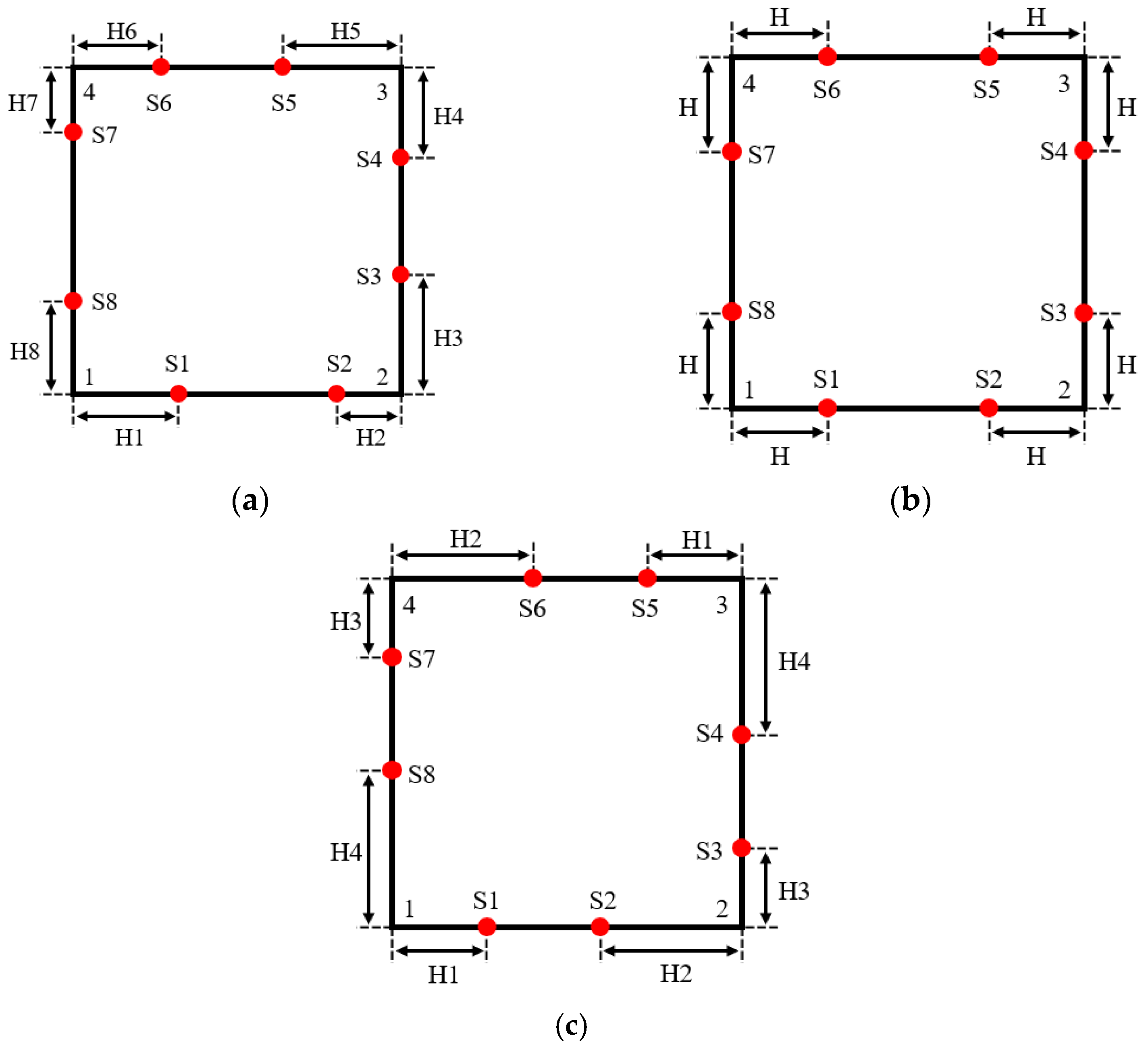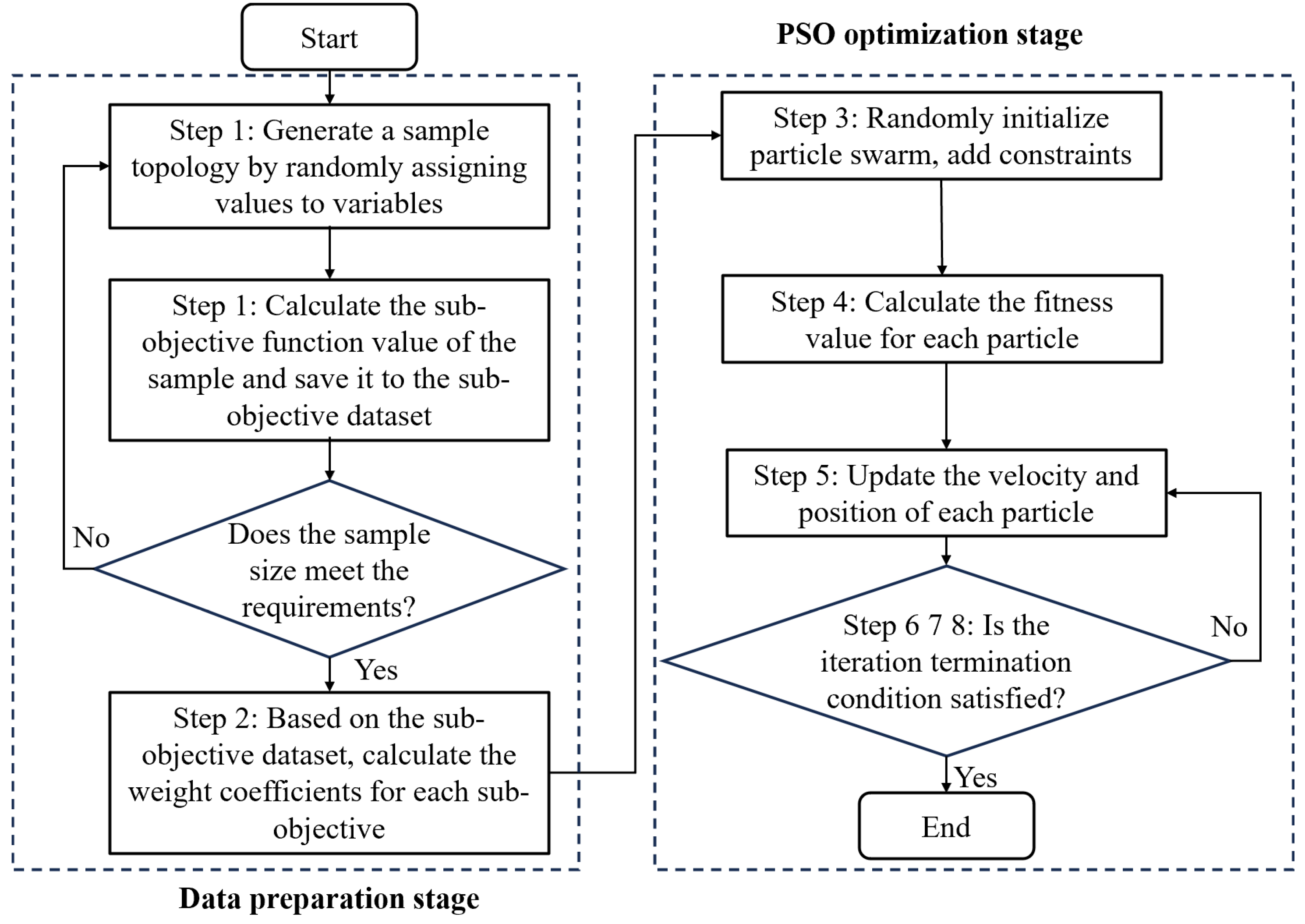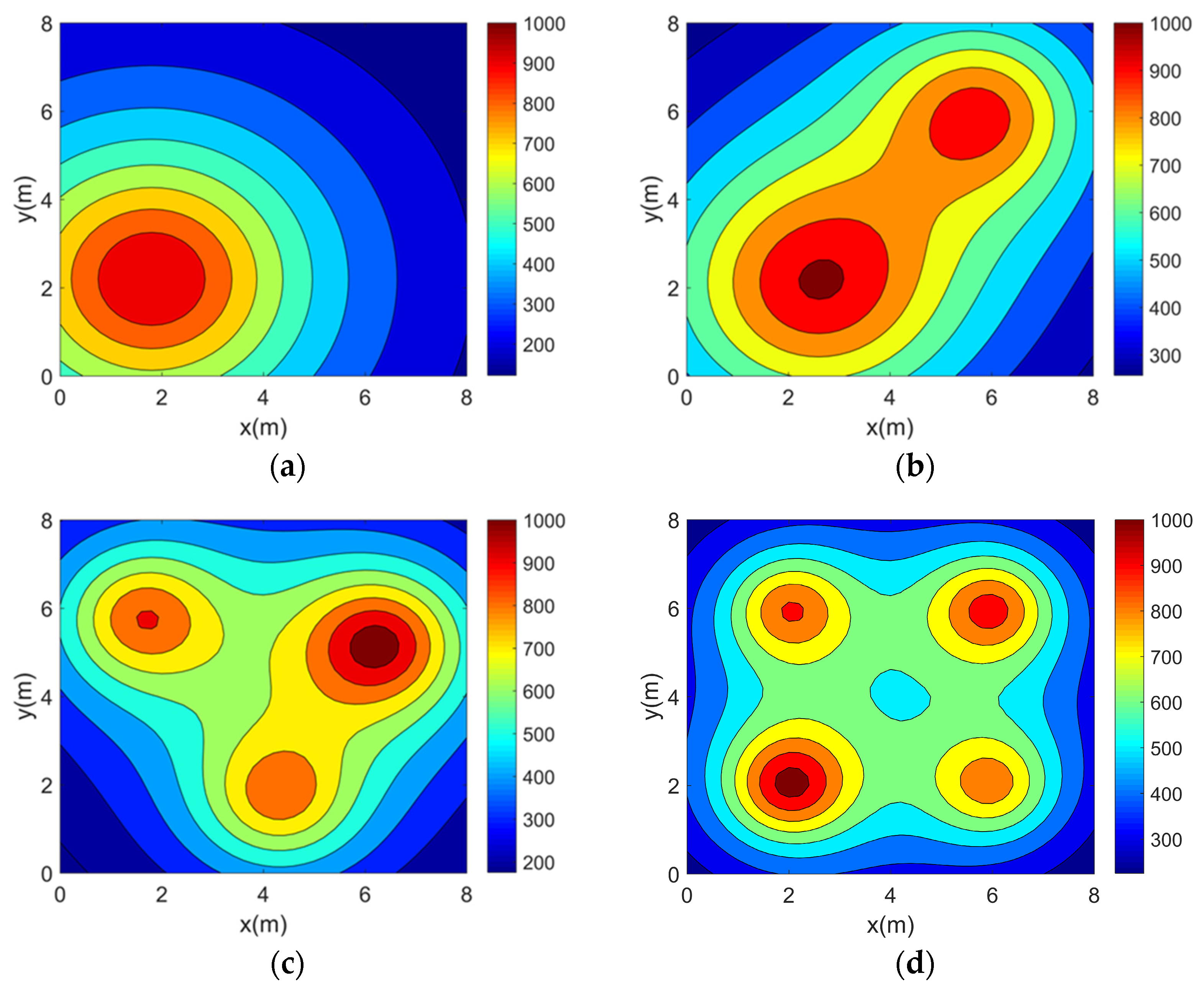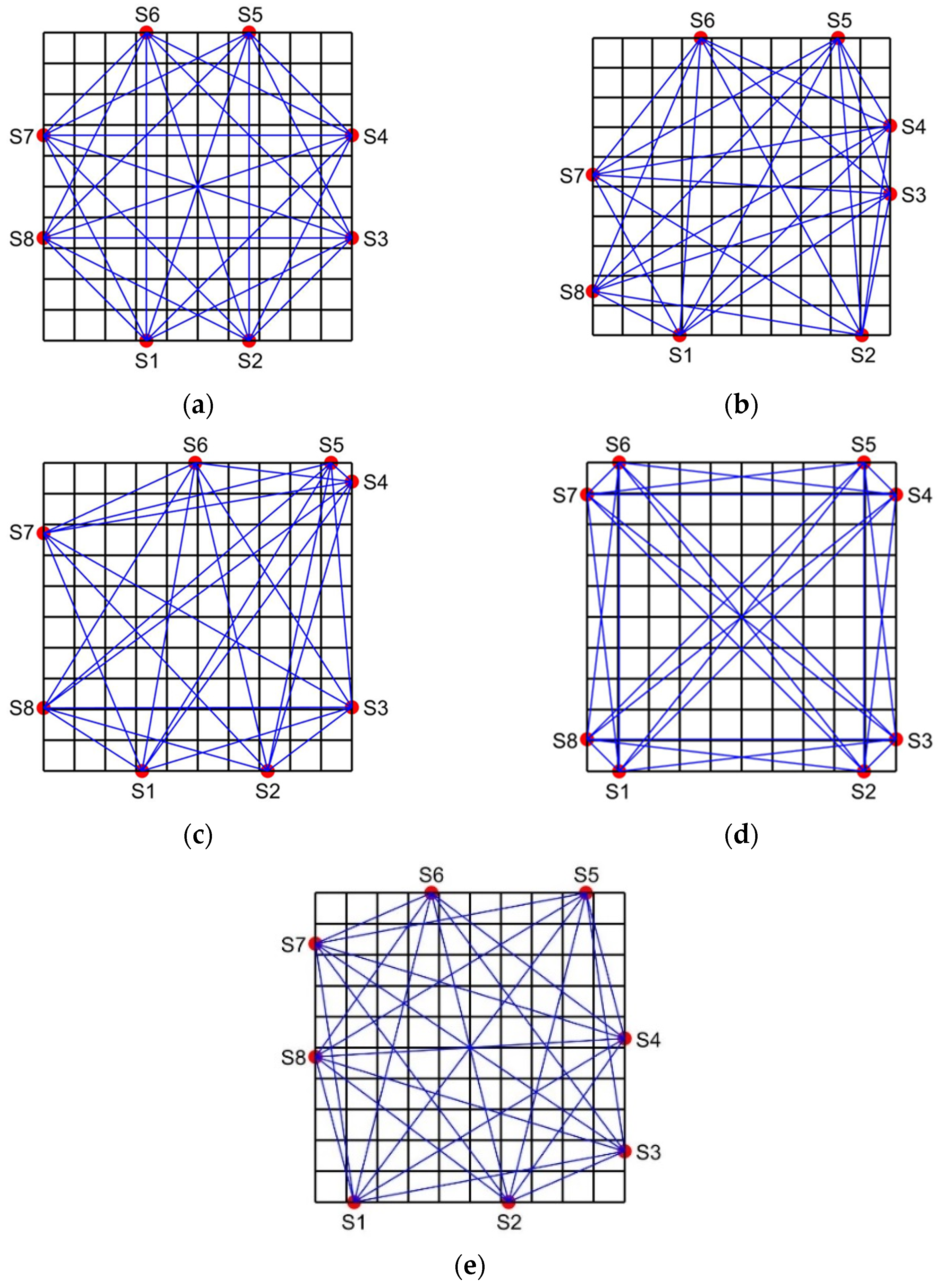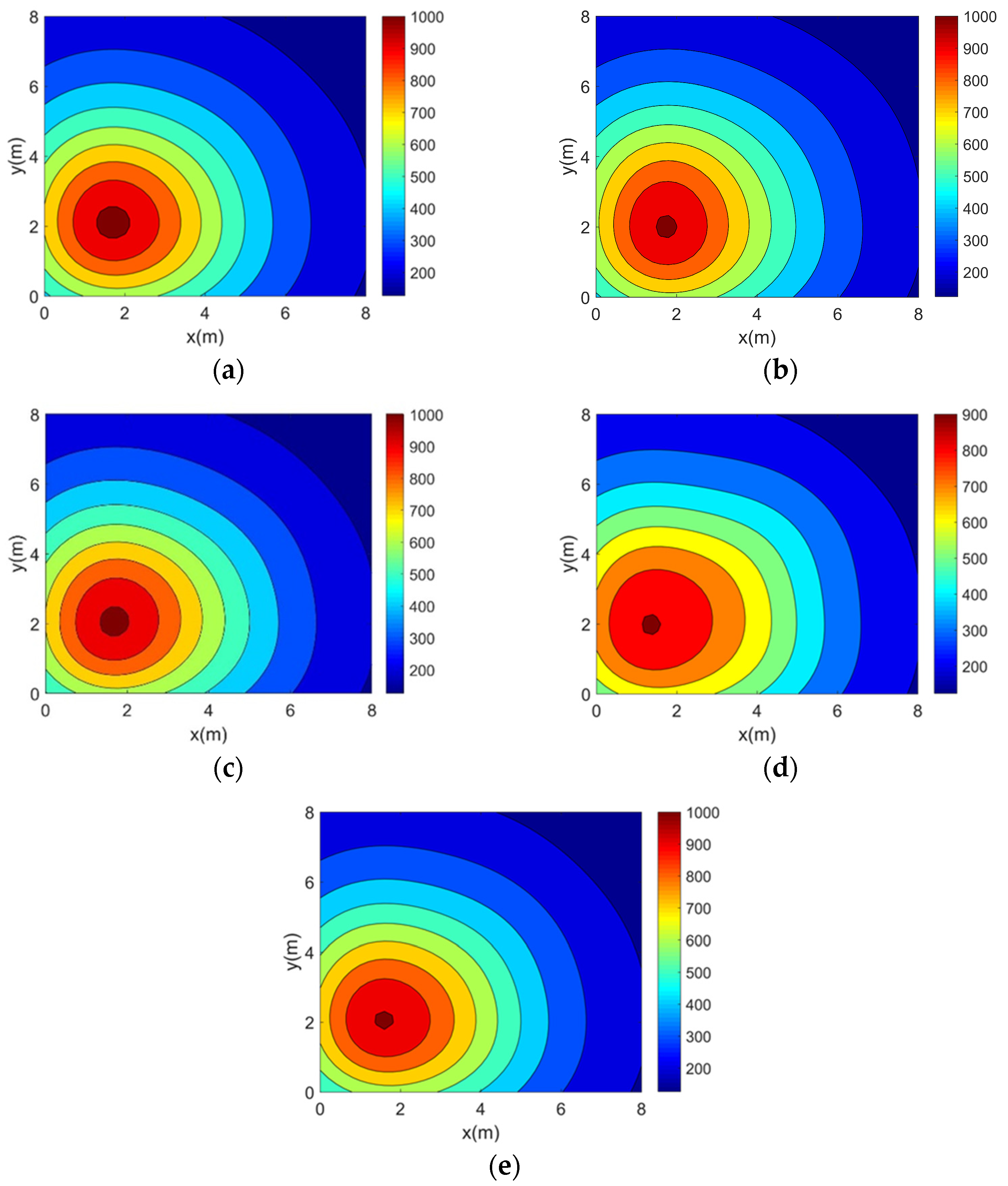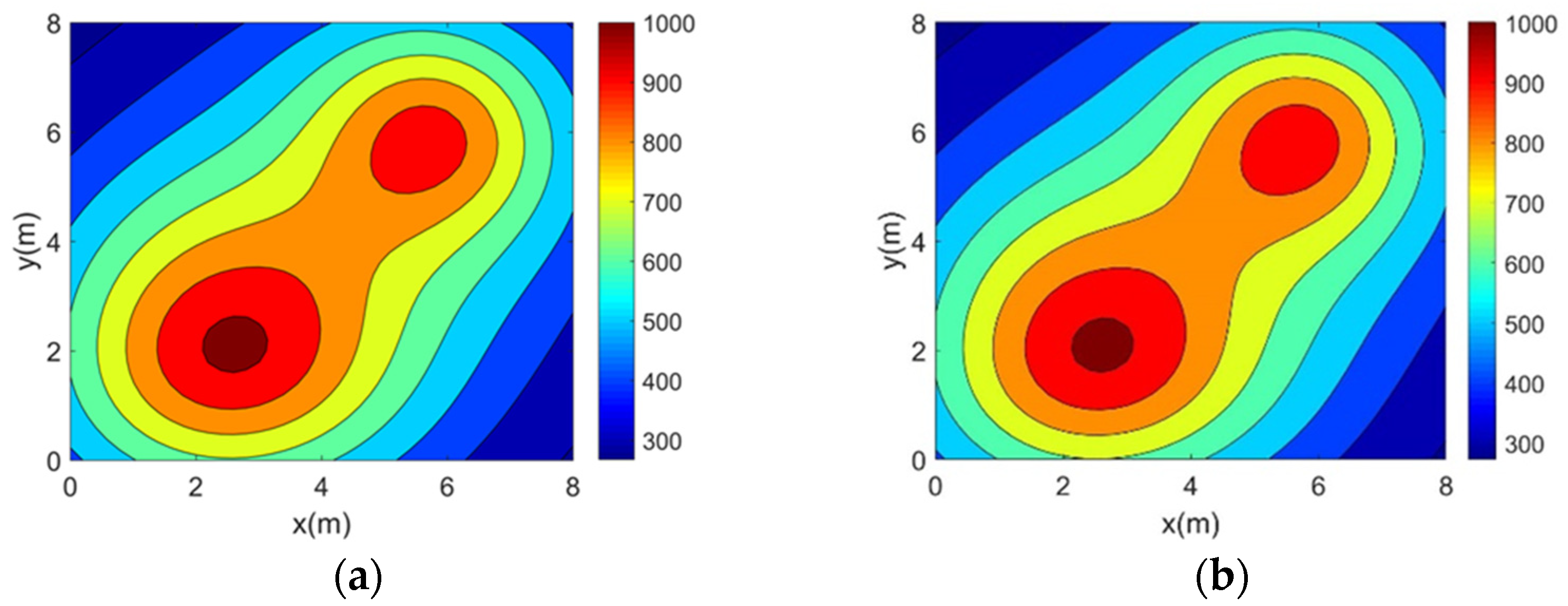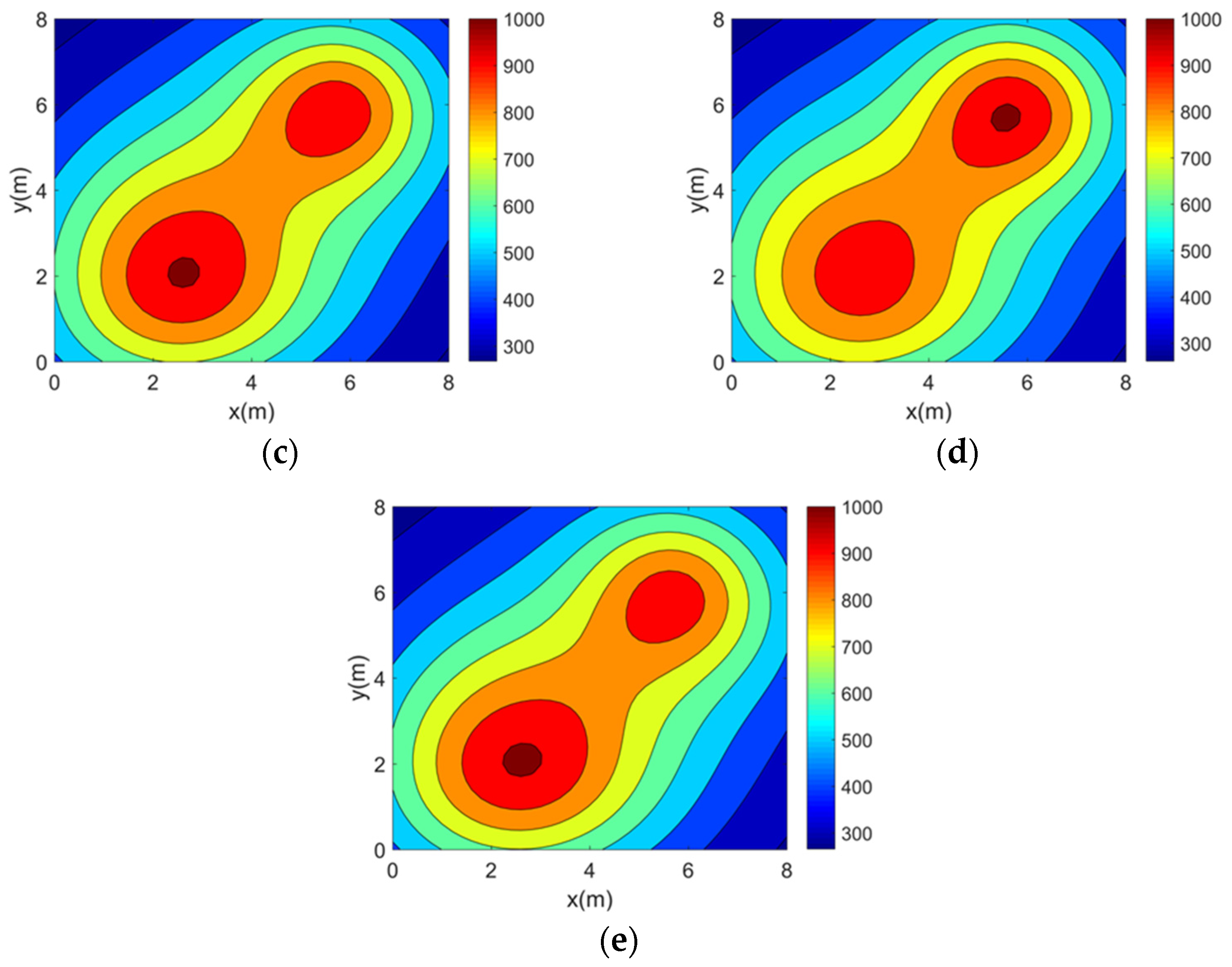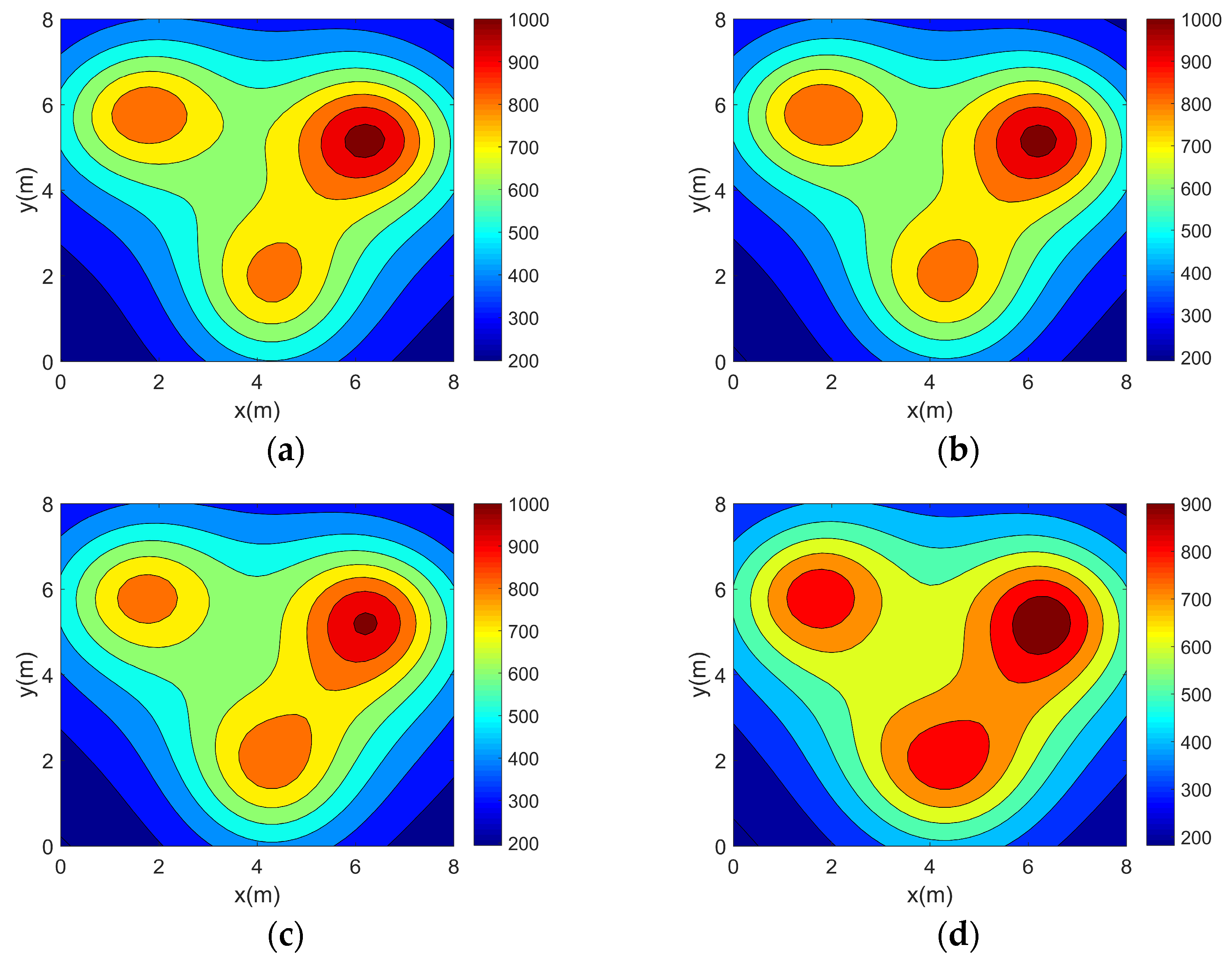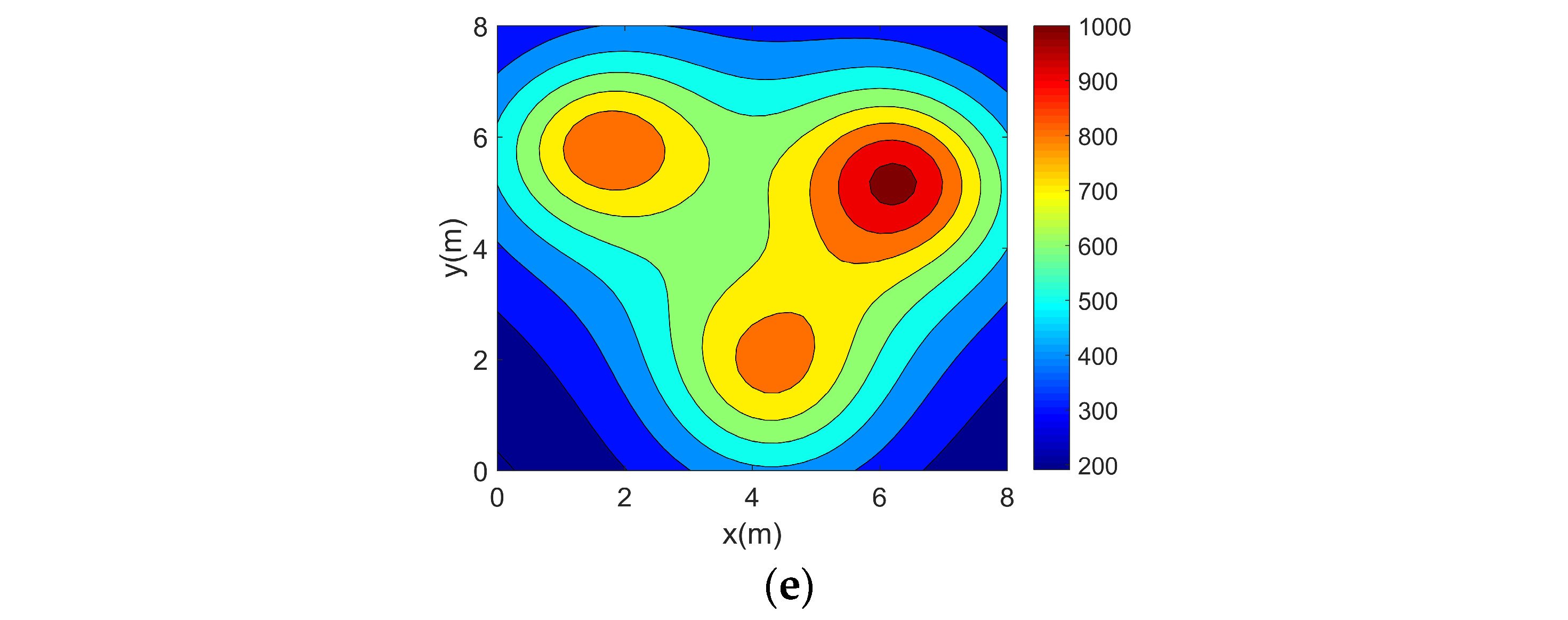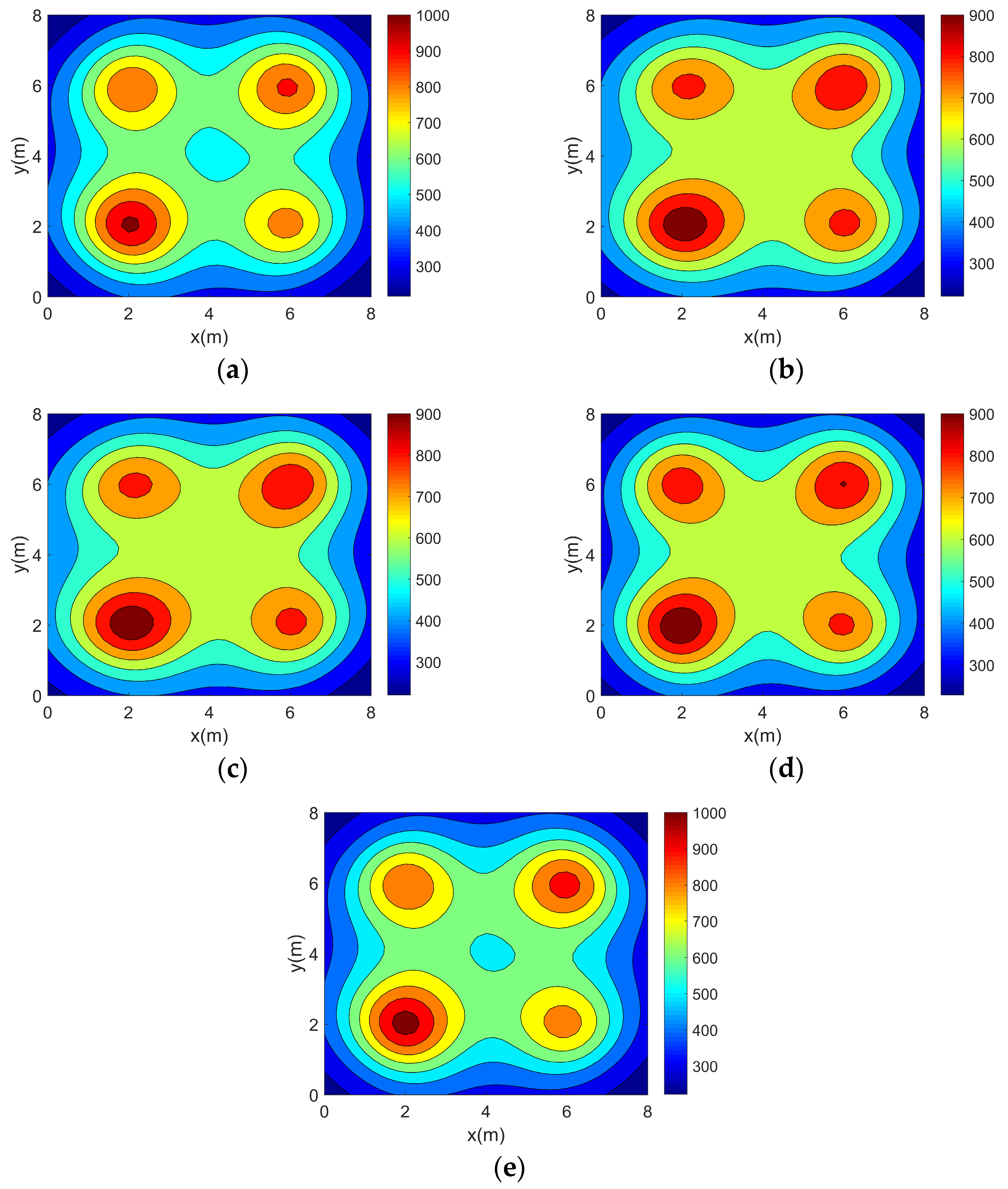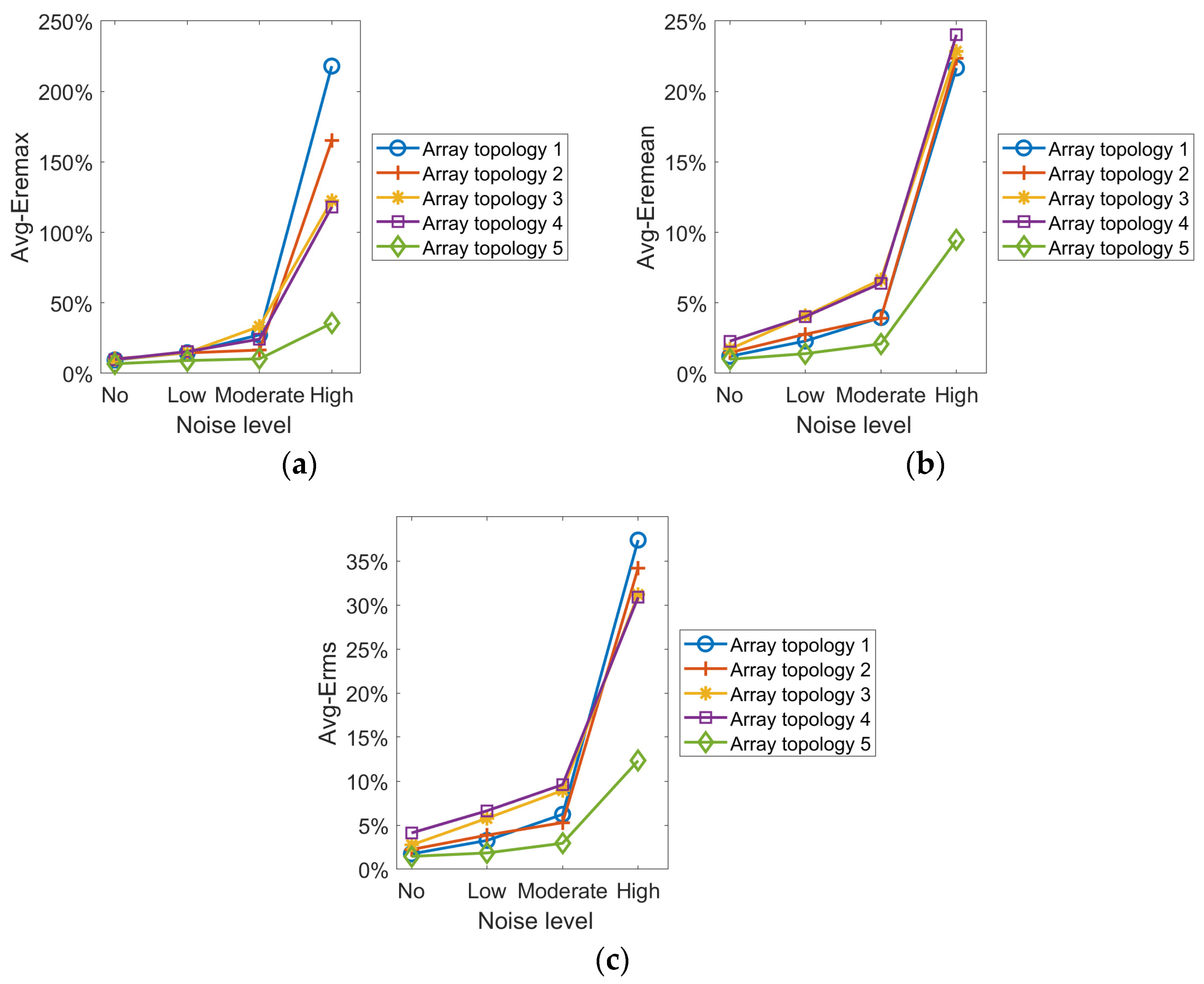3.2. Effectiveness Verification of the Optimization Method
In this section, validation experiments on the effectiveness of the optimization method (including the optimization objective and optimization variable) will be carried out separately based on the optimization process of
Section 2.2.3. In order to facilitate the later description, the optimization method in [
14] is referred to as Method 1, and its optimization objective is referred to as Objective 1. The optimization methods in [
13,
15,
16] are referred to as Method 2, and their optimization objectives are referred to as Objective 2. The optimization method in [
11] is referred to as Method 3, and its optimization objective is referred to as Objective 3. The optimization method in this paper is referred to as Method 4, and its optimization objective is referred to as Objective 4. Additionally, the optimization variables are defined as follows: Variable 1 for Method 1 and Method 2, Variable 2 for Method 3, and Variable 3 for Method 4.
(1) Effectiveness validation of optimization objective
The effectiveness verification of the optimization objective is carried out first. Based on the experimental conditions in
Section 3.1, the weights for the four sub-objectives in Objective 4 are determined as
= 0.3193,
= 0.1572,
= 0.1669, and
= 0.3566. The objective function
is expressed as follows:
The objective function (Objective 4) constructed in this paper assigns greater weight to the root mean square error of the reconstructed uniform temperature field and acoustic path coverage, while reducing the influence of the path matrix condition number and acoustic path orthogonality on optimization performance. To validate the effectiveness of Objective 4—measuring the correlation between reconstruction errors for different temperature fields—this section compares it with Objective 1, Objective 2, and Objective 3. The Pearson correlation coefficients between the above four optimization objectives and the four temperature field reconstruction errors were computed under 100 random topologies, as shown in
Table 1,
Table 2 and
Table 3.
Analysis shows that Objective 1 has an extremely weak correlation with the reconstruction errors of the single-peak, three-peak, and four-peak temperature fields. Although its correlation with the double-peak field is relatively higher (supporting the findings in [
14]), it remains weak, indicating that Objective 1 cannot effectively characterize topology reconstruction performance. Objective 2 shows an extremely weak correlation with the reconstruction errors of all temperature fields, with some coefficients (except for the single-peak field) being negative. This suggests that using Objective 2 for optimization may not only fail to improve reconstruction accuracy but could even worsen the results. Compared with Objective 1 and Objective 2, Objective 3 shows significantly stronger correlations with reconstruction errors: weak for the single-peak field, moderate for the double-peak field, and strong for the three-peak and four-peak fields. This indicates that Objective 3 can partially characterize topology reconstruction performance. Notably, Objective 4 exhibits stronger correlations with reconstruction errors than the other three objectives: moderate for the single-peak field and strong for the double-peak, three-peak, and four-peak fields. In summary, Objective 4 better characterizes topology reconstruction performance and is more effective for improving temperature field reconstruction.
(2) Effectiveness validation of optimization variable
In order to verify the validity of Variable 3, it is compared with Variable 1 and Variable 2 in this section. The experimental scheme involves setting the optimization variables as Variable 1, Variable 2, and Variable 3 within Method 4. The resulting topologies are then used to reconstruct the four temperature fields. The error data of the reconstruction results (obtained on the basis of 41 × 41 = 1681 temperature calculation points) are shown in
Table 4,
Table 5 and
Table 6.
Analysis of the error data shows that Variable 3 minimizes all error indicators except for the double-peak and four-peak temperature fields. For Variable 3, the average across the four temperature fields is below 7%, 1.0246% and 1.7299% lower than Variable 1 and Variable 2, respectively. The average is below 1%, 0.5865% and 0.0620% lower than Variable 1 and Variable 2, respectively. The average is below 1.5%, 0.9762% and 0.0620% lower than Variable 1 and Variable 2, respectively. In summary, Variable 3 outperforms Variable 1 and Variable 2 in reconstructing all four temperature fields, making it a more effective optimization variable for improving reconstruction results.
(3) Optimization results and performance evaluation
The transducer’s topology, which was achieved by optimization using Methods 1, 2, 3, and 4, is depicted in
Figure 5, along with the conventional trisection uniform topology. In this paper, we conducted approximately 50 optimization experiments on all optimization methods and found that the experimental results of all optimization methods were relatively stable. Therefore, only one representative experimental result is presented in this paper.
Hereafter, the topologies are labeled as follows: Topology 1 for the trisection uniform topology, Topology 2 for the topology optimized by Method 1, Topology 3 for the topology optimized by Method 2, Topology 4 for the topology optimized by Method 3, and Topology 5 for the topology optimized by Method 4.
Topology 1 exhibits good symmetry and relatively uniform acoustic path distribution. However, some sub-temperature zones near the four vertices of the measured region lack acoustic path coverage, leading to increased reconstruction errors at the edges. Topology 2 and Topology 3 lack symmetry. In Topology 2, S6 and S7 are far apart, resulting in sparse acoustic paths in the upper left corner and insufficient temperature information, compromising reconstruction accuracy. In Topology 3, S4 and S5 are too close, causing dense acoustic paths in the upper right corner and sparse coverage elsewhere, making it difficult to ensure universality across different temperature fields. Topology 4 maintains axial symmetry, but the transducers are too close to the vertices, leading to a nonuniform acoustic path distribution. Many paths traverse the edges and diagonals, while other areas have sparse coverage, resulting in uneven reconstruction accuracy. Additionally, some sub-temperature zones are crossed by only one acoustic path, reducing path quality. In contrast, Topology 5 demonstrates central symmetry and a more uniform acoustic path distribution, avoiding extreme density or sparsity. Most sub-temperature zones are crossed by more than two acoustic paths, ensuring high path quality.
In summary, the optimized transducer topology proposed in this paper provides more uniform acoustic path distribution, enabling higher-quality coverage of the measured region and supporting high-precision reconstruction of various temperature fields.
A. Accuracy experiment of optimization results
In this section, the accuracy experiment of the optimization method is carried out. Simulation reconstructions of four 2D asymmetric complex temperature fields using the five topologies mentioned above are carried out and the reconstruction results are shown in
Figure 6,
Figure 7,
Figure 8 and
Figure 9.
It can be seen from the above reconstructed images that all of the reconstruction results can better characterize the original distribution of the corresponding temperature fields. For the single-peak temperature field, all five topologies achieve good reconstruction results, though Topology 4 shows a larger deviation in temperature range compared with the original field. For the double-peak temperature field, Topology 4 accurately captures the number and location of heat sources but fails to describe the size relationship between the peaks. The other four topologies perform well with minimal differences. For the three-peak temperature field, the temperature range error of the reconstruction results of Topology 4 is relatively large, while the other topologies all have better reconstruction results. For the four-peak temperature field, Topology 2, Topology 3, and Topology 4 exhibit larger temperature range errors. Topology 3 and Topology 4, in particular, show lower resolution and fail to finely characterize the gradient in the center region. In contrast, Topology 1 and Topology 5 provide a more accurate description of the overall temperature distribution.
Table 7,
Table 8 and
Table 9 show the error data (obtained based on 41 × 41 = 1681 temperature calculation points) for the five topologies for the four temperature field reconstruction results.
Analyzing the above error data, it can be seen that all of the error indicators of the reconstruction results of Topology 5 are optimal. For Topology 5, the average across the four temperature fields is 6.7953%, which is 2.6745%, 3.4971%, 2.8467%, and 3.06% lower than Topology 1, Topology 2, Topology 3, and Topology 4, respectively. The average is 0.9963%, 0.2142%, 0.4778%, 0.7235%, and 1.2863% lower than the other four topologies, respectively. The is 1.4587%, 0.2841%, 0.777%, 1.2926%, and 2.6582% lower than the other four topologies, respectively. It can be concluded that Topology 5 has higher reconstruction accuracy for all four temperature fields. This experiment shows that in asymmetric complex temperature fields, the topologies derived from the optimization approach in this study exhibit high accuracy.
B. Stability experiment of optimization results
In addition to accuracy, the measured topology must exhibit good stability (anti-interference capability) to ensure precise temperature field reconstruction in noisy environments. The stability validation experiment evaluates the five topologies by adding three levels of Gaussian noise (mean 0, standard deviations: 0.00005 s for low noise, 0.0001 s for moderate noise, and 0.0005 s for high noise) to the acoustic TOF. The expression for the acoustic TOF after the introduction of the noise is given as follows:
where
denotes the measured value of the TOF,
denotes the true value of the TOF, and
denotes the TOF measurement error caused by combustion noise.
The global reconstruction error data (obtained based on 41 × 41 = 1681 temperature calculation points) for the five topologies at different noise levels are shown in
Table 10,
Table 11,
Table 12 and
Table 13.
From the experimental results in the tables and for the identical temperature field, the reconstruction error increases with noise level. In various noise levels, Topology 5 is optimal in all error metrics and has the best stability for all temperature field reconstruction results. For the low noise, the of single-peak, double-peak, three-peak and four-peak temperature fields reconstructed by Topology 5 are at least 1.7144%, 0.9276%, 2.0489% and 0.9372% lower than that of other topologies, respectively. For the moderate noise, the of single-peak, double-peak, three-peak and four-peak temperature fields reconstructed by Topology 5 are at least 2.1946%, 1.0791%, 2.2026% and 1.9692% lower than that of other topologies, respectively. For the high noise, the of single-peak, double-peak, three-peak and four-peak temperature fields reconstructed by Topology 5 are at least 10.4905%, 7.8515%, 19.5241% and 5.7876% lower than that of other topologies, respectively.
To evaluate the overall performance of the topologies across the four temperature fields, the average reconstruction errors for each topology under different noise levels are calculated separately, as shown in
Figure 10.
It can be seen from the preceding experimental data that the reconstruction error rises with noise level for the same field. Under the low noise condition, each topology can basically reconstruct all temperature fields. However, under moderate and high noise conditions, the reconstruction accuracy of all topologies, except for Topology 5, decrease significantly, and some fail to accurately depict the temperature field’s distribution. Different topologies vary in their ability to resist noise interference. Across noise levels, Topology 5 achieves overall optimization by synthesizing reconstruction results from each temperature field. The results demonstrate that the optimization strategy suggested in this work has a great anti-interference capacity in addition to having a high reconstruction accuracy.
